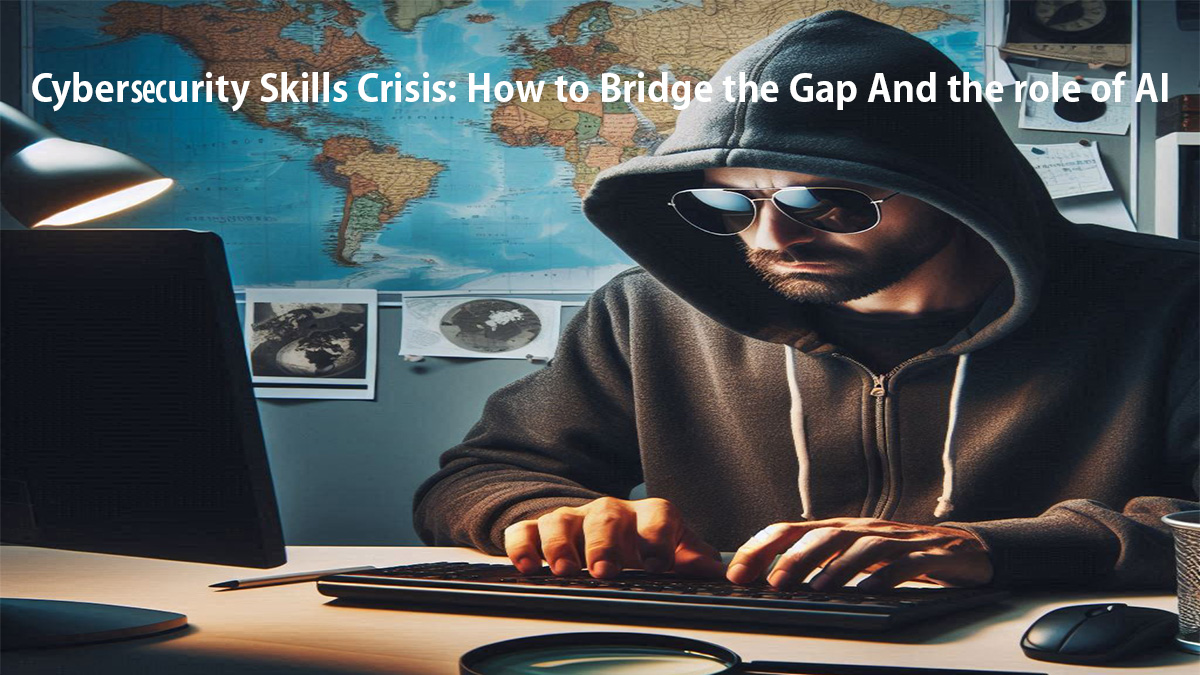Cybersecurity Skills Crisis: How to Bridge the Gap And the role of AI

The cybersecurity job market has experienced a remarkable surge in recent years, with a notable increase in the number of vacant positions. Cyber leaders like CISOs, CSOs, and other security-focused executives, as well as business leaders, are facing a major challenge due to the scarcity of resources and skills in this field. Despite this obstacle, the demand for cyber resilience continues to rise steadily.
As technology advances and cyber threats become more sophisticated, organizations are recognizing the critical importance of having strong cybersecurity measures in place. This has led to a growing need for skilled professionals who can protect sensitive data, networks, and systems from potential cyber attacks.
In order to address the shortage of qualified cybersecurity professionals, companies are investing in training programs, certifications, and partnerships with educational institutions.
By developing a pipeline of talented individuals with the necessary skills and expertise, organizations can better defend against cyber threats and ensure their overall security posture.
prioritizing cyber resilience and closing the gap
Cyber and business leaders are in unanimous agreement that the biggest obstacle to achieving cyber resilience within their organizations is the lack of resources and skills.
In today’s digital age, where cyber threats are constantly evolving and becoming more sophisticated, having a strong cybersecurity posture is essential for any business. However, many organizations struggle to keep up with the rapid pace of change in the cybersecurity landscape.
One of the main reasons for this gap in resources and skills is the shortage of qualified cybersecurity professionals. The demand for skilled cybersecurity experts far outweighs the supply, making it difficult for organizations to find and retain top talent.
This shortage not only hinders an organization’s ability to effectively defend against cyber threats but also leaves them vulnerable to potential attacks.
Another contributing factor to this barrier is the lack of investment in cybersecurity training and education. Many organizations fail to prioritize cybersecurity awareness and training programs for their employees, leaving them ill-equipped to recognize and respond to potential threats. Without proper training, employees may inadvertently fall victim to phishing scams or other social engineering tactics used by cybercriminals.
To address this gap in resources and skills, organizations must invest in ongoing cybersecurity training for their employees, as well as recruiting and retaining top cybersecurity talent.
By prioritizing cybersecurity education and awareness within their organizations, business leaders can help bridge the gap and strengthen their overall cyber resilience. It is crucial for businesses to recognize that investing in cybersecurity is not just a cost but an essential part of doing business in today’s digital world.
constant debate among business and cyber leaders
In the world of cybersecurity, there is a constant debate among business and cyber leaders about the importance of securing legacy technology and overcoming cultural resistance to change in order to achieve cyber resilience.
Some believe that outdated systems pose a significant barrier to protecting against cyber threats, while others argue that cultural resistance within organizations is just as challenging.
Those who advocate for securing legacy tech point to the fact that many older systems lack the necessary security features to defend against modern cyber attacks. These systems may have vulnerabilities that can be exploited by hackers, putting sensitive data at risk.
Upgrading or replacing these systems can be costly and time-consuming, but it is seen as essential for maintaining a strong defense against cyber threats.
On the other hand, those who focus on cultural resistance argue that even the most advanced technology is useless if employees do not follow proper security protocols.
Changing organizational culture to prioritize cybersecurity awareness and best practices can be a daunting task, especially in large companies with entrenched ways of doing things. Overcoming this resistance requires strong leadership, effective communication, and ongoing training initiatives.
Ultimately, both securing legacy tech and addressing cultural resistance are crucial components of achieving cyber resilience. Business and cyber leaders must work together to find a balance between upgrading technology and fostering a culture of security within their organizations. By tackling these challenges head-on, companies can better protect themselves against the ever-evolving threat landscape in today’s digital world.
Bureaucratic hurdles
Public organizations and medium- to low-revenue organizations are facing significant challenges due to resource and skill shortages. These organizations often struggle to attract and retain talented employees, resulting in a lack of expertise in key areas. This can lead to decreased efficiency, lower productivity, and ultimately hinder the organization’s ability to achieve its goals.
One of the main reasons for this issue is the limited budget available to these organizations. With fewer financial resources, they may not be able to offer competitive salaries or invest in training programs to develop their employees’ skills. As a result, talented individuals may choose to work for higher-paying private sector companies instead.
Additionally, public and low-revenue organizations may also face bureaucratic hurdles that make it difficult to quickly hire new staff or implement changes to address skill shortages. This can further exacerbate the problem and create a cycle of inefficiency within the organization.
To address these challenges, public and low-revenue organizations can explore alternative solutions such as partnering with educational institutions for training programs, implementing flexible work arrangements to attract top talent, or leveraging technology to automate repetitive tasks and free up employees’ time for more strategic work.
By recognizing the impact of resource and skill shortages on their operations and taking proactive steps to address these issues, public organizations and medium- to low-revenue organizations can position themselves for long-term success and better serve their stakeholders.
Is AI a threat to cybersecurity jobs?
With the rise of artificial intelligence (AI) technology, many are left wondering if it poses a threat to cybersecurity jobs. While AI has the potential to automate certain tasks and make processes more efficient, it also brings with it new challenges for cybersecurity professionals.
One concern is that AI could potentially replace some traditional cybersecurity roles by automating routine tasks such as threat detection and response. This could lead to a decrease in demand for human workers in these areas. However, it’s important to note that AI is not a one-size-fits-all solution and still requires human oversight and expertise to function effectively.
On the other hand, AI also presents new opportunities for cybersecurity professionals. With the increasing complexity of cyber threats, AI can help enhance security measures by quickly analyzing vast amounts of data and identifying patterns that may indicate a potential attack. This allows cybersecurity experts to focus on more strategic tasks and proactive measures to protect against evolving threats.
How AI is reshaping the cybersecurity job landscape
As technology continues to advance, the role of artificial intelligence (AI) in reshaping the cybersecurity job landscape is becoming increasingly apparent.
According to ISC2’s AI study, 88% of cybersecurity professionals believe that AI will have a significant impact on their jobs, either now or in the near future. In fact, 35% of these professionals have already seen the effects of AI in their work.
One way that AI is changing the cybersecurity job landscape is by automating routine tasks and processes. This allows cybersecurity professionals to focus on more strategic and complex issues, rather than spending time on repetitive tasks. Additionally, AI can analyze vast amounts of data much faster and more accurately than humans, helping to identify potential threats and vulnerabilities more efficiently.
Another way that AI is reshaping the cybersecurity job landscape is by enhancing threat detection and response capabilities. AI-powered tools can quickly detect unusual patterns or behaviors that may indicate a cyber attack, allowing security teams to respond proactively before any damage is done. This real-time threat intelligence enables organizations to stay ahead of cyber threats and protect their sensitive data effectively.
Overall, as AI continues to evolve and become more integrated into cybersecurity practices, it will undoubtedly change the nature of cybersecurity jobs. While some tasks may be automated, new roles requiring advanced technical skills in AI and machine learning will emerge. Cybersecurity professionals will need to adapt to these changes by developing new skills and staying up-to-date with the latest technological advancements in order to remain effective in their roles.
AI is reshaping the cybersecurity job landscape by automating routine tasks, enhancing threat detection capabilities, and creating new opportunities for skilled professionals. By embracing these changes and continuously learning and evolving with technology, cybersecurity professionals can stay ahead of cyber threats and protect organizations from potential attacks effectively.
How AI Is Disrupting And Transforming The Cybersecurity Landscape
AI technology is revolutionizing the cybersecurity landscape in both positive and negative ways. On one hand, AI-powered tools are helping organizations detect and respond to cyber threats more efficiently than ever before. On the other hand, cybercriminals are also leveraging AI to launch more sophisticated attacks.
One of the key factors driving the rise of cybercrime is the accessibility of hacking tools and services. Cybercriminals no longer need advanced technical skills to carry out attacks, as they can simply purchase subscription services or starter kits on the dark web. This lower barrier to entry has led to an increase in the number and complexity of cyber threats.
Additionally, the use of large language models (LLMs) like ChatGPT poses a new challenge for cybersecurity professionals. These models can be used to generate convincing phishing emails, malware code, or even deepfake videos that are difficult to distinguish from legitimate content. As a result, organizations must stay vigilant and continuously update their security measures to defend against AI-powered attacks.
In conclusion, while AI technology offers many benefits for improving cybersecurity defenses, it also presents new challenges that organizations must address. By staying informed about emerging threats and investing in advanced security solutions, businesses can better protect themselves from cyberattacks in this rapidly evolving digital landscape.
AI can also serve as a powerful ally in safeguarding our digital assets
In the realm of cybersecurity, the spotlight often shines on the potential risks and threats posed by artificial intelligence. However, it is crucial to acknowledge that AI can also serve as a powerful ally in safeguarding our digital assets. Here are five ways in which AI can be leveraged for our protection:
- AI has the ability to make inferences: By analyzing vast amounts of data and recognizing patterns, AI can predict potential cyber threats before they materialize, allowing for proactive defense strategies.
- AI can provide continuous monitoring: Unlike human analysts who may miss subtle signs of an impending attack, AI-powered systems can tirelessly monitor networks 24/7, ensuring that any suspicious activity is promptly detected.
- AI can help identify false positives: One of the challenges in cybersecurity is distinguishing between genuine threats and harmless anomalies. AI algorithms excel at filtering out false alarms, reducing unnecessary alerts and preventing alert fatigue.
- AI can be used to strengthen access control measures: Through biometric authentication and behavioral analysis, AI technology can enhance access control protocols, making it harder for unauthorized users to breach sensitive systems.
- AI can be used to mitigate insider threats: Employees with malicious intent pose a significant risk to organizations. AI tools can monitor user behavior and detect unusual patterns that may indicate insider threats, enabling swift intervention before damage occurs.
By harnessing the capabilities of artificial intelligence in these areas, we can bolster our defenses against cyberattacks and stay one step ahead of cybercriminals. It’s time to shift the narrative from fear of AI to embracing its potential as a valuable asset in our cybersecurity arsenal.







